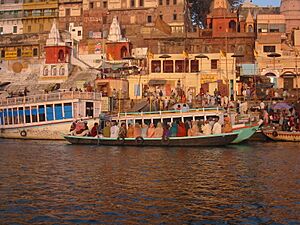Ghat facts for kids

A Ghat is a term used in the Indian subcontinent. It can mean two main things. First, it can be a series of steps leading down to a body of water, like a river or pond. These steps are often used for bathing, washing clothes, or religious ceremonies. Famous examples include the Ghats in Varanasi or Dhobi Ghat.
Second, 'Ghat' can also refer to a range of stepped hills or mountains with valleys. The Eastern Ghats and Western Ghats are examples of these mountain ranges. Roads that go through these mountain passes are sometimes called Ghat Roads.
Contents
What Does the Word "Ghat" Mean?
The word 'Ghat' comes from an ancient Indian language called Sanskrit. In Sanskrit, it means things like a landing place, a quay (a place where boats can dock), or steps by a river.
Different Kinds of Ghats
Mountain Ghats
The word ghati (which sounds like 'gha-tee') means valley in some Indian languages. In parts of India, 'Ghat' can describe a challenging path over a mountain. For example, the Bhor Ghat connects two towns near Mumbai.
Often, the term 'Ghat' refers to an entire mountain range. The two most famous mountain ranges called Ghats are the Western Ghats and the Eastern Ghats. They run along the coasts of India.
Western Ghats: A Special Mountain Range
The Western Ghats are also known as Sahyadri, meaning "Benevolent Mountains." This mountain range stretches for about 1,600 kilometers (almost 1,000 miles) along India's western coast. It covers states like Kerala, Tamil Nadu, Karnataka, Goa, Maharashtra, and Gujarat.
The Western Ghats are a UNESCO World Heritage Site. This means they are very important globally. They are one of the world's "hottest hot-spots" for different kinds of plants and animals. Many species found here live nowhere else on Earth. Scientists believe the Western Ghats are even older than the Himalayan mountains.
These mountains also play a big role in India's weather. They block the rain-filled monsoon winds that come from the southwest in late summer, causing heavy rainfall on the western side. The range separates a high flat land called the Deccan Plateau from a narrow coastal plain along the Arabian Sea. Many national parks and wildlife areas within the Western Ghats are protected as world heritage sites.
Eastern Ghats: Mountains on the East Coast
The Eastern Ghats are a series of mountains along India's eastern coast. They are not continuous like the Western Ghats; they are broken up. These mountains stretch from northern Odisha down through Andhra Pradesh to Tamil Nadu.
Four major rivers of India, the Godavari, Mahanadi, Krishna, and Kaveri, cut through these mountains. The Eastern Ghats run parallel to the Bay of Bengal. The Deccan Plateau is to their west.
The Eastern Ghats are older than the Western Ghats. They have a complex geological history, meaning they were formed a very long time ago when ancient supercontinents were coming together and breaking apart. These mountains are made of various types of rocks like charnockites and granites. Important minerals like limestone, bauxite, and iron ore are found in the Eastern Ghats.
River Ghats
These are the steps or platforms built on the banks of a river. People use them for many purposes.
Varanasi Ghats
The city of Varanasi has many famous ghats along the Ganges River, about 88 of them! Most of these were built by different rulers, like Queen Ahilyabai Holkar in the 18th century.
In central India, there are also important ghats along the Narmada River.
Cremation Ghats
Some ghats are specifically used for religious ceremonies, like cremations. A "shmashana" or "cremation" ghat is where bodies are cremated by the water. The ashes can then be released into the river.
Famous cremation ghats include Nigambodh Ghat and Raj Ghat in Delhi on the Yamuna River. Raj Ghat is where Mohandas Karamchand Gandhi was cremated. Another well-known one is the Manikarnika Ghat at Varanasi on the Ganges.
"Ghat" in Place Names
The word "Ghat" is also part of many place names across the Indian subcontinent. Here are a few examples:
- Balaghat, India
- Balurghat, India
- Devghat, Nepal
- Golaghat, India
- Pasighat, India
Ghats Outside India
The word 'Ghat' is also used in some places outside the Indian subcontinent. For example, in George Town, Penang in Malaysia, you might see streets ending with "Ghaut." This shows where the street used to go down to the water with steps before the land was changed.
In both Penang and Singapore, there are places called Dhoby Ghaut. "Dhoby" means "launderer" or "laundry," so these were places where clothes were washed.
Aapravasi Ghat in Mauritius
The Aapravasi Ghat is a special building complex in Port Louis, Mauritius. It means "The Immigration Depot." From 1849 to 1923, about half a million Indian workers arrived here. They were "indentured laborers," meaning they had signed contracts to work on plantations across the British Empire.
This large movement of people had a huge impact on many former British colonies. In Mauritius, for example, about 68 percent of the people today have Indian ancestors. Because of this, the Immigration Depot is a very important historical and cultural site for Mauritius.
See also
 In Spanish: Ghat (hinduismo) para niños
In Spanish: Ghat (hinduismo) para niños
- Ghats in Varanasi
- Ghat Roads
- Temple tank
Images for kids
-
A painting from the late 1700s showing Pune with a cremation ghat in the front.



